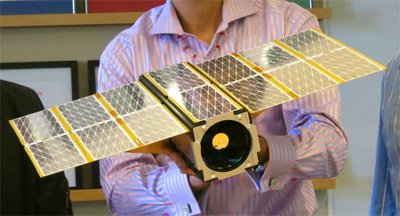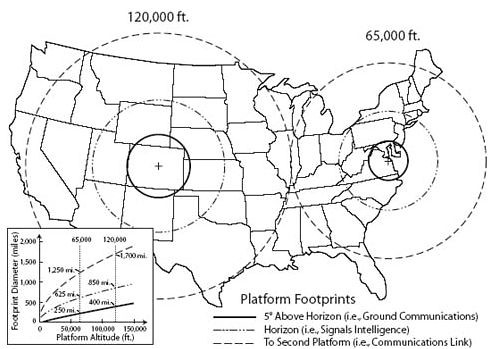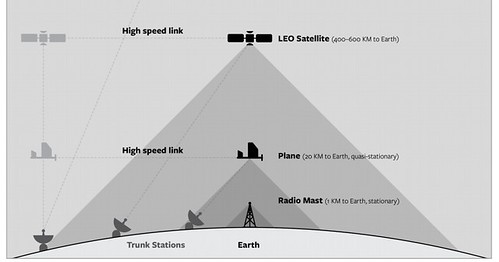Google plans to spend more than $1 billion on a fleet of satellites to extend Internet access to unwired regions of the globe, reports the Wall St Journal.
The project reportedly will start with 180 small, high-capacity satellites orbiting the earth at lower altitudes than traditional satellites, and then could expand.
Google’s satellite venture is led by Greg Wyler, founder of O3b Networks , a medium orbit satellite constellation that delivers backhaul to cell sites, which Google has also invested in. Google has also been hiring engineers from satellite company Space Systems/Loral LLC to work on the project.
Google has also invested in Project Loon, a series of high-altitude balloons to provide broadband to remote parts of the world, and Titan Aerospace, which is building solar-powered drones to provide similar connectivity. Facebook has its own drone effort.
O3b has been planning to launch about a dozen satellites, aiming to serve large areas on either side of the equator. Each O3B will weigh approximately 700 kilograms (1,500 lb) with the beams covering 700 km in diameter (435 miles). The O3b and Iridium NEXT systems (700kg and 800kg respectively) cost at least $40M per satellite to build and launch.
Google small satellite venture hopes to cover the entire globe with satellites weighing less than 250 pounds (113 Kilograms). The International Telecommunication Union (ITU), which regulates satellite orbital slots and spectrum, shows L5/WorldVu filings as promising to start service in late 2019.
SkyBridge had a similar idea using the Ku-band. It was abandoned for lack of financing, and it is the legacy SkyBridge frequencies that L5/WorldVu proposes to use.
The SkyBridge system would use 80 satellites orbiting at 1,500 km, in 20 orbital planes with four equally spaced satellite per plane. The circular orbital planes would have been inclined at 53 degrees from the equator, 18 degrees apart.
Google’s satellites, apparently, will operate in circular orbits of 800 and 950 kilometers inclined 88.2 degrees relative to the equator, have been given regulatory deadlines of between late 2019 and mid-2020 to enter service, according to ITU records, using the Ku band (12/14 GHz).
Google’s approach might be contrasted with Iridium NEXT spacecraft, the successor to the current constellation, and due to begin launching in the first quarter of 2015. Iridium’s satphone service uses a lower frequency (1.6 GHz), but are no speed demons for internet access.
Iridium NEXT may cost a total of $3 billion. It will have 72 operational satellites and in-orbit spares, orbiting at 780 km × 780 km, cicular orbits, inclined 86.4°.
Each Iridium Next spacecraft employs an L-band (1.6 GHz) phased array antenna for generation of the 48-beam, 4,700 km diameter cellular pattern for direct communication with users. The cross-linked 66 satellite constellation forms a global network in space. Ka-band links provide ground-based backhaul and in-orbit crosslinks.
Satellite consultant Tim Farrar estimated that 180 small satellites could be launched for as little as about $600 million. But the full 360 satellite system would likely cost $3B for the 100kg satellites and $4B-$5B for the 200-300kg satellites.
Farrar says the planned system is expected to involved 360 LEO Ku-band satellites using a filing by WorldVu in Jersey. He believes the constellation will have 18 planes of 20 satellites, with half at an altitude of 950km and the remainder at 800km. The higher altitude satellites provide global coverage, and the lower satellites being added later, in between the initial 9 planes, provide additional capacity.
It’s not immediately clear how the end user terminals and backhaul could work. Kymeta’s new flat panel beamforming antenna, might eliminate the need for tracking dishes, but they’re not practical on mobile phones. Secondly, if the satellite footprint covers the size of a state (with a million people), then supplying the needed backhaul capacity could be problematic.
Countries can own their geosynchronous airspace. Iridium, Globalstar and Orbcomm, among others, are Low Earth Orbit (LEO) satellites that require different rules because they fly over many different countries.
Low Earth Orbit (LEO) satellites are in an orbit about 400 to 800 miles above the Earth’s surface. ORBCOMM’s 30 satellites, are capable of sending and receiving alphanumeric packets, but can’t provide real-time internet access.
ORBCOMM’s 12 Gateway Earth Stations connect with satellites as they pass overhead on four continents, maintaining satellite connectivity and near-real-time messaging capabilities.
Planet Labs’ mini photo satellites were released from the International Space Station in December, 2013.
Planet Labs wants to create – essentially – a live view version of Google Earth. Four satellites were launched February 2013 in what is expected to become a steady stream of miniature satellites ejected from the ISS.
Near-space platforms at 12 miles (20K meters/65K feet) are 20 times closer than a typical 400-kilometer LEO satellite at 250 miles. High altitude UAVs can stare — 24/7 — without blinking or human needs. Mercury’s sigint computers are powered by nVidia GPUs and Intel processors for TeraFLOPS processing.
IEEE Spectrum has Five Ways to Bring Broadband to the Backwoods, including solar-powered drones, MEO and LEO satellites, balloons, blimps, and White Spaces.
The move to “High Throughput Satellites” will be key to success in broadband access around the world, says Northern Sky. The geostationary Ka-band satellites already have a spot-beam solution. But, except for Inmarsat and Intelsat, they’re not global.
LEO satellites are one way Google could deliver global access to the internet. Their investment in medium orbit O3B indicates they are serious. But it may be more of a political solution rather than an engineering solution. And it would be no political walk in the park. Private US ventures such as these may have been essentially killed off by the snoops at the NSA.
Related DailyWireless Space and Satellite News includes; Dish Turns On Satellite Broadband, EchoStar XVII Broadband Satellite Launched, High Throughput Satellite Goes Live, ViaSat Announces Commercial Satellite Operation, FCC Promotes Rural Broadband Solutions, EchoStar XVII Broadband Satellite Launched, ViaSat-1 Passes Test, ViaSat-1 Launched, Google Buying Drone Company Titan, Facebook Announces Connectivity Lab, Amazon & Globalstar Test Wireless Service, GlobalStar Promotes “Licensed” WiFi in 2.4 GHz band, OuterNet: CubeSat Datacasting?, Satellite Swarms Revolutionize Earth Imaging , Planet Labs’ Photo CubeSats Released, Arctic Technology, Sea Launch: 15 Years Later, Facebook Buying Drone Company, Inside Google’s Loon Project, Project Loon Field Trip Hangout, First Four O3B Satellites Launched, Google Backhaul: Balloons & Satellites, Kymeta’s Flat Beamforming Antenna Links to Satellite, Blimp In A Box, ExactEarth Launches 5th AIS Satellite, Dish: Lower 700MHz Power Ups Speculation, Earth to Space Optical Communications – Again, O3B: Funded for Launch, Arianespace: Busy 2013, Gilat Does Satellite Cell Backhaul, SkyTerra 1 Launched, Broadband Satellites: Black Hole?
Posted on Mon, 02 Jun 2014 15:30:48 +0000 at http://www.dailywireless.org/2014/06/02/...or-google/
Comments: http://www.dailywireless.org/2014/06/02/.../#comments









